Choosing the right materials
To start painting a seascape with oil paints, it’s important to gather the right materials first. You will need a set of oil paints, brushes of different sizes, a palette for mixing colors, a palette knife, canvas or canvas board, and odorless turpentine or mineral spirits for cleaning your brushes and thinning the paint.
Preparing the canvas
Before you begin painting, it’s crucial to prepare the canvas. If you are using a canvas, make sure it’s stretched tightly on a frame. If you are using a canvas board, it’s ready to use as is. Apply a thin layer of gesso to the canvas or canvas board and let it dry completely. This will create a smooth and even surface for your paint to adhere to.
Sketching the composition
Once you have your materials ready, you can start sketching the composition of your seascape. Use a pencil or thin brush to lightly sketch the main elements such as the horizon line, the sea, the sky, and any boats or other objects you want to include in your painting. It’s important to get the proportions and perspective right at this stage.
Building layers and adding details
Begin by blocking in the basic shapes and colors of your seascape. Start with the sky and the horizon line, then gradually work your way down to the water, the waves, and any other elements you have included in your composition. Use larger brushes for the background and smaller brushes for adding details. Remember to work from the background to the foreground, allowing each layer to dry before adding the next.
Adding final touches and finishing
Once you are satisfied with the overall composition and colors of your seascape, it’s time to add the final touches and make any necessary adjustments. This is where you can add details such as reflections on the water, waves crashing against rocks, or the texture of sand on the beach. Use a palette knife to add texture and create interesting effects. Finally, let your painting dry completely before varnishing it to protect it and enhance its colors.






